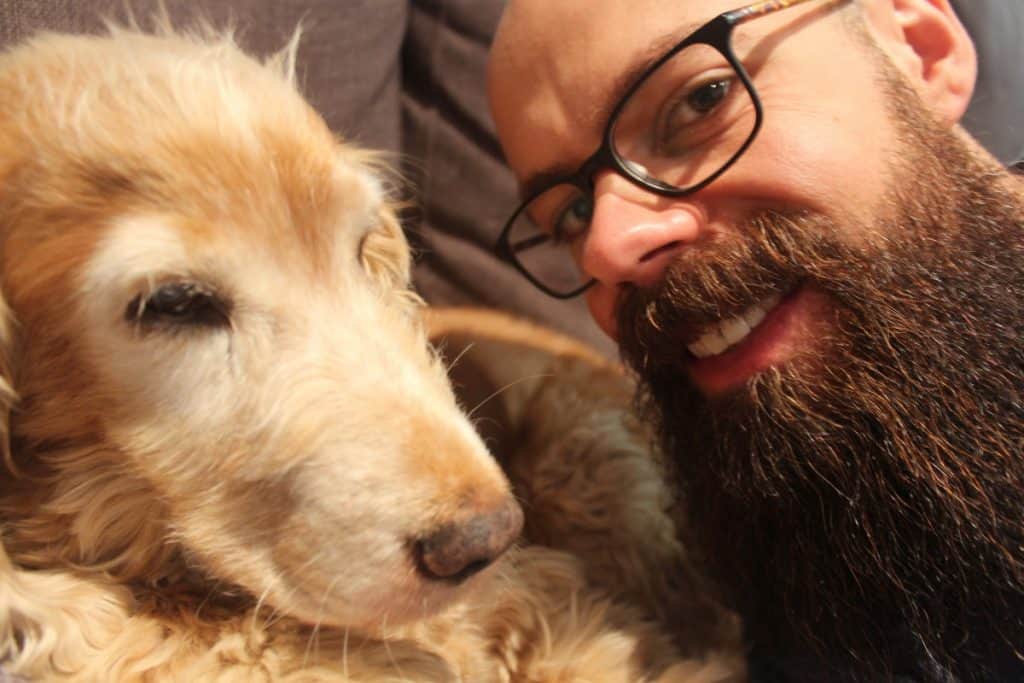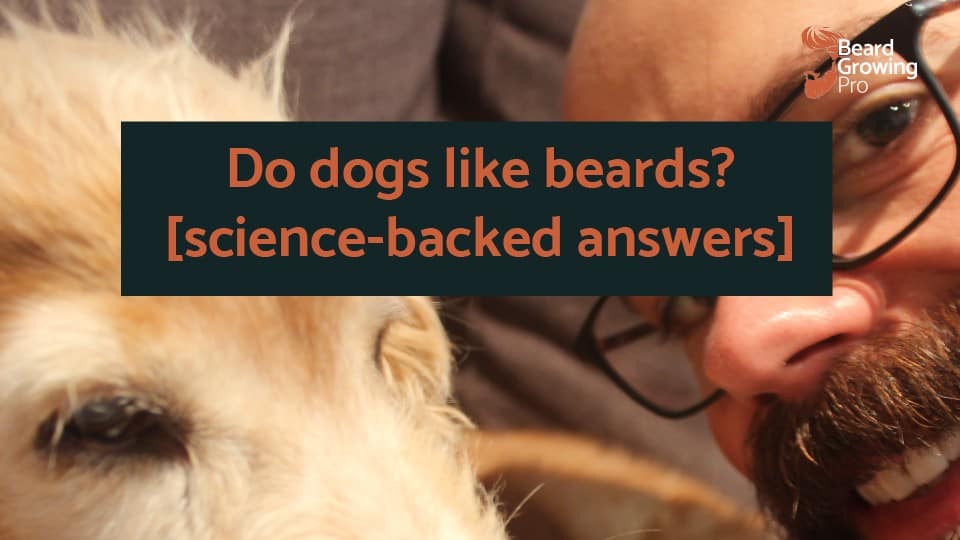Is there any animal more trusted and cared for by humans than the loyal dog? Dogs rely on visual and audio cues to connect with their owner. Some dogs have been said to absolutely love beards. Whilst others bark and growl at the sight of a beard. In this article we are going to work out whether or not dogs are generally less friendly and less trusting towards men with beards. I have looked at the scientific evidence as well as peoples anecdotal experience of what their dog does when it sees a bearded man. Do dogs like beards? Let’s take a look!
The science shows us that dogs use primarily use the eyes as a way of distinguishing and recognising human faces. However, some dogs can use the lower half of the face to determine emotions displayed by a human. A beard could easily throw off a dog’s perception of the emotional qualities of an interaction and combined with their poor eyesight resolution, beyond 6 m, may scare a timid dog.
Let’s look in more detail at the science around how dogs perceive the human face and what sort of cues they used to determine the emotion displayed by humans.

Answers from science – do dogs like beards?
It is well-known that faces play a very important role in communication in social animals such as domesticated dogs and cats. Domestic dogs respond to human facial cues often, but they are expected to have a relatively weak ability to process that facial cue.
How dogs process information
A study published in 2013, highlighted how dogs processed human faces. In their study they used facial inversion effect (where the faces were depicted upside down) and responses to people who were familiar to them to monitor the eye tracking of 23 pet dogs and eight kennel dogs.
The reason this study looked at kennel and pet dogs was to establish and compare the difference between dogs with different life experiences. The scientists thought that maybe there would be a difference in facial recognition scanning from dogs that had been around a loving family as opposed to dogs which had spent the majority of their life in kennels.
The study found that dogs spent a lot of time looking at the eye area of the human face. When the faces were the right way up, the eye area gathered a longer total duration and greater fixation on the eye area.
If the dog was personally familiar with a face it attracted more fixations than faces that they had never seen before. This told the researchers that the dogs are likely to be able to recognise human faces in photographs.
The results imply that the way the dog’s scan faces is guided by the physical properties of the image and also other semantic factors. This means that a beard could easily throw off how a dog views faces and may confuse the dog as to where the eyes are on a person. This confusion can result in the dog feeling unfamiliar and uneasy with a bearded face and therefore become aggressive towards that person.
Facial images were more attractive for pet dogs rather than dogs that had lived in kennels but their life experience did not affect the way that they scanned the face. This tells us that the basic mechanisms of face processing in dogs could be an inherent or hardwired response or, at least, have developed under limited exposure to human faces.
To properly understand how you a dog could process a face we need to understand exactly how dogs see the world. It isn’t as well resolved as the human eye. That’s because dogs have an incredible sense of smell which they use as their primary sense.
How dogs perceive humans
Another study published in 2016 looks at how dogs perceive and understand humans.
This study tried to answer the question of what dogs see when they look at people. Dogs cannot tell you what they can see what they know so the scientist used behavioural experimental procedures to figure out what the dogs see. The visual system of a dog evolved to function well in low light. That is one reason why dogs have limited colour vision.
One question that the researchers wanted to explore was whether or not the dogs associate what a person looks like with how they sound. To work this out the researchers played the voice of the dog’s owner and then showed them a picture of either the owner or an unfamiliar person. Dogs looked longer at the picture if it was a picture of an unfamiliar person. This suggests that the voice paired with an unfamiliar face violated the dogs expectation and so the dog looked longer in that situation to try to work out what on earth was going on.
This study also confirmed the above study where they noticed that dogs pay particular attention to the eyes of a face.
The dogs were also able to recognise differences between at least some of the human facial expressions for our emotions. It’s really hard to work out what they look at and how they actually perceive the different emotions.
Interestingly, the researchers were able to train dogs to discriminate between a happy and angry face by using only the lower half of the face (the nose, mouth and chin) after learning to discriminate is faces the dogs were then shown the top half of the same face as well as the bottom and top part of new faces that they were not trained on. The dogs were able to discriminate between the happy and angry faces for each one.
This could give us a little bit of an indication as to why dogs are thrown off by beards. The study suggests that dogs can use the mouth area to distinguish between emotions. Any hair that is covering the mouth or chin or cheeks of an individual could throw off how the dog is perceiving the interaction. Having a beard could easily throw off the way a dog perceives the interaction with an individual and therefore can become confused and angry if the dog perceives the emotion displayed by an individual as angry – even though that is not the case and is just obscure would buy a beard.
How dogs see the world
A dog’s vision is very different to human visions. There are some basic biological factors that come into play such as the number of receptors in the back of the eye as well as the types of receptors and how the eye responds to different colours.
A dogs vision and the way it can see the world depends on a number of things.
The position of the eyes on an animal’s head depends how much of the world it can see through its two eyes. Animals with eyes pointing forward see a much shallower angle of the world and typically are predator animals. A dogs field of vision is about 240° while a human can expect to have a field of vision of about 200°.
Dogs are very sensitive to movement. Some studies have predicted that dogs can see movement from up to 800 m away. However, they are not able to focus and distinguish the tween different objects at that distance. A dog can distinguish between two different objects that are about 6 m away from. A typical person can see about 25 m away.
How dogs see the world can be viewed in this YouTube video from tech insider:
You’ll notice that is very different from how we view the world and the reduced visual acuity at a distance of greater than 6 m can easily account for why some dogs do not like beards as they can seem unfamiliar to them.
Some dogs hate beards!
Some dogs absolutely hate beards. The Internet is full of forums where people are saying that their dog is triggered into Barking by seeing someone that has a beard.
If your dog is not used to seeing people with beards (or it can be any foreign things such as hats, coats, canes, wheelchairs and more) it can set them off into a barking and aggressive mode. Some breeds can be more prone to the sort behaviours if they feel like something is different or off and this can include any physical attributes or accessories that they have not seen very often.
This YouTube video helps explain why it is common for some dogs to become reactive to something that is out of the ordinary:
if your dog has not been exposed to beards or any other type of physical attribute or accessory it may provoke a reaction like in the video above. The way you can overcome your dog barking up beards is by slowly exposing the dog to the thing that it doesn’t like whilst treating and rewarding calm behaviour.
Some dogs love chewing beards!
Some dogs absolutely love chewing on hair and biting beards. It is very common with younger dogs that they will pull and tug at your hair. There isn’t much scientific information available on this subject but looking at very simple dog behaviour we can work out if it is an affectionate behaviour or something we need to worry about.
One theory is that dogs love to play with hair because they simply enjoy the texture of it in their mouth. It’s probably that your dog really likes the course and wiry nature of your beard. There is also other theories to suggest that dogs are just trying to get you to interact with them by biting or tugging at your hair. It’s like them asking you for attention and a bit of a play time.
As long as the dog is not actively ingesting excessive amounts of hair it should be fine for them to pull at the hair as long as it is welcomed by the person with the beard.
There are also a number of forums online such as Reddit where they talk about how much dogs absolutely love to chew on their beard.
Past trauma
Another reason why dogs may react differently to beards is if they have any past trauma associated with people with beards.
If your dog has been mistreated in the past or has been abused by a person which has a beard it is likely that the dog will either express timidness, or aggression towards individuals with beards.
Although this can be a very hard thing to train out of a dog with a slow and steady exposure routine it is possible to get even the most traumatised of dogs to accept bearded people as friends.
Summary
The science and the anecdotal evidence seem to suggest that some dogs like beard hair while others do not like beards.
Dogs use a number of facial cues to determine whether or not a person is angry or sad. Whilst they mainly focus on the eyes of a subject they can also use the lower half of the face (such as the mouth, chin, cheeks) to determine the emotion of the person they are looking at. The dog’s poor eyesight may also contribute to how it perceives the beard and anything unusual may cause the dog to react in an angry or timid way.
As long as the dog hasn’t got any past traumatic events in its life related to bearded people mistreating it you can train the barking behaviour out of the dog by slowly introducing the beard to the environment whilst actively rewarding positive behaviour.
It can be hard to determine exactly what dogs think of a beard, but it is very much dependent on the individual dog.



